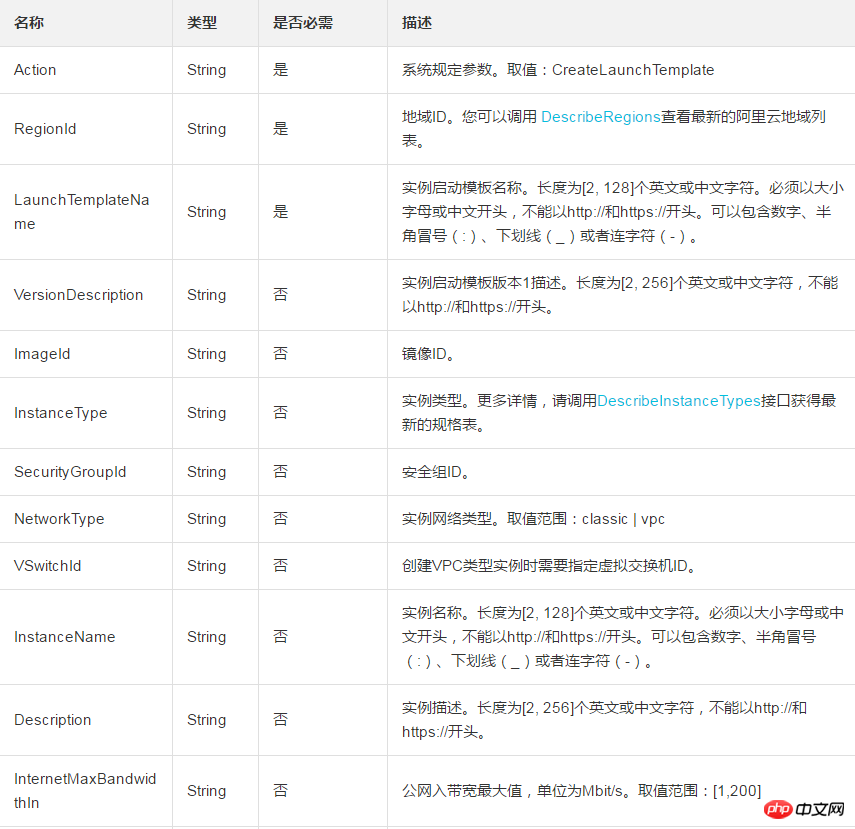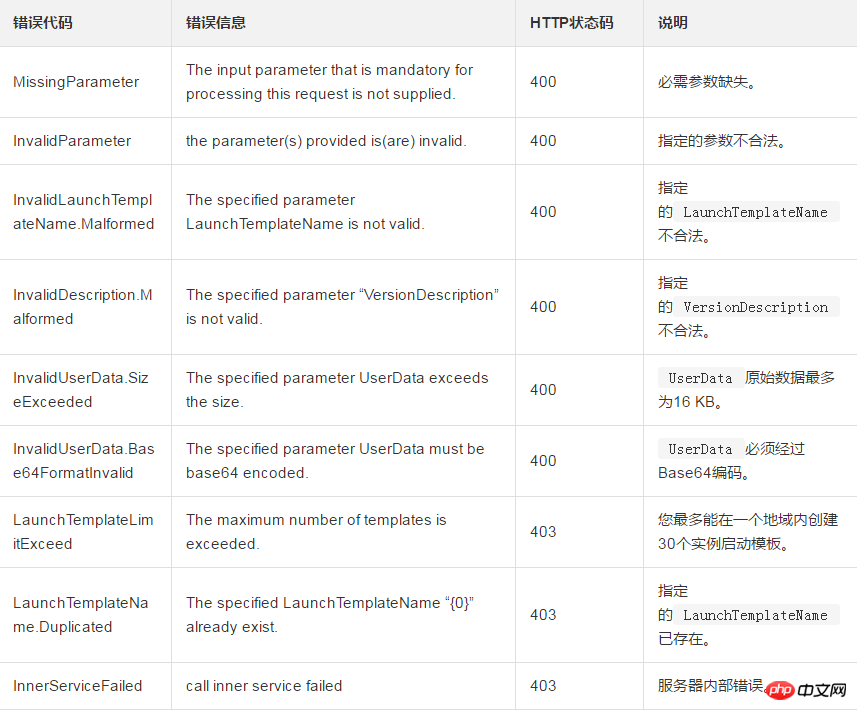 Operation and Maintenance
Operation and Maintenance
 Linux Operation and Maintenance
Linux Operation and Maintenance
 How to eliminate the need to fill in a large number of configuration parameters every time you create an instance - Create an instance startup template
How to eliminate the need to fill in a large number of configuration parameters every time you create an instance - Create an instance startup template
How to eliminate the need to fill in a large number of configuration parameters every time you create an instance - Create an instance startup template
The content of this article is about how to avoid the need to fill in a large number of configuration parameters every time you create an instance. It has certain reference value. Friends in need can refer to it. I hope it will be helpful to you. help.
CreateLaunchTemplate
Create an instance launch template, referred to as a template. Instance launch templates eliminate the need to fill in a large number of configuration parameters every time you create an instance.
Description
The instance startup template contains related configurations for creating instances, such as the region to which the instance belongs, image ID, instance specifications, and security Group ID and public network bandwidth, etc. If an instance configuration is not specified in the template, you need to specify the configuration for the instance when you create it. After creating a template (CreateLaunchTemplate), the initial version of the template is 1. You can subsequently create multiple template versions (CreateLaunchTemplateVersion) based on this version. The version numbers increase sequentially starting from 1. If you do not specify a template version number when creating an instance (RunInstances), the default version will be used.
When calling this interface, you need to note:
You can create up to 30 instance startup templates in a region, and each template can have up to 30 versions.
Most of the parameters of the instance startup template are optional parameters. When creating a template, we will not verify the existence and validity of parameter values in the template. The validity of parameter values will only be verified when the instance is actually created.
If a certain configuration is set in the instance startup template, the configuration cannot be filtered out when creating the instance (RunInstances). For example, if the template sets HostName=LocalHost and the value of HostName in RunInstances is empty, the host name of the instance is still LocalHost. If you want to override the configuration HostName=LocalHost, you can set HostName=MyHost or other parameter values in RunInstances.
Request parameters

##Return parameters

Example
Request Example
https://ecs.aliyuncs.com/?Action=CreateLaunchTemplate &RegionId=cn-hangzhou &LaunchTemplateName=lt-name1 &InstanceType=ecs.cm4.6xlarge &SecurityGroupId=sg-securitygroupid &<公共请求参数>
Return example
XML format
<CreateLaunchTemplateResponse>
<RequestId>04F0F334-1335-436C-A1D7-6C044FExxxxx</RequestId>
<LaunchTemplateId>lt-m5eiaupmvm2op9dxxxxx</LaunchTemplateId>
</CreateLaunchTemplateResponse>JSON format
{
"RequestId": "04F0F334-1335-436C-A1D7-6C044FExxxxx",
"LaunchTemplateId": "lt-m5eiaupmvm2op9dxxxxx"
}Error code
The following are error codes unique to this interface. For more error codes, please visit the API Error Center.
The above is the detailed content of How to eliminate the need to fill in a large number of configuration parameters every time you create an instance - Create an instance startup template. For more information, please follow other related articles on the PHP Chinese website!

Hot AI Tools

Undresser.AI Undress
AI-powered app for creating realistic nude photos

AI Clothes Remover
Online AI tool for removing clothes from photos.

Undress AI Tool
Undress images for free

Clothoff.io
AI clothes remover

Video Face Swap
Swap faces in any video effortlessly with our completely free AI face swap tool!

Hot Article

Hot Tools

Notepad++7.3.1
Easy-to-use and free code editor

SublimeText3 Chinese version
Chinese version, very easy to use

Zend Studio 13.0.1
Powerful PHP integrated development environment

Dreamweaver CS6
Visual web development tools

SublimeText3 Mac version
God-level code editing software (SublimeText3)

Hot Topics
 1670
1670
 14
14
 1428
1428
 52
52
 1329
1329
 25
25
 1274
1274
 29
29
 1256
1256
 24
24
 Linux Architecture: Unveiling the 5 Basic Components
Apr 20, 2025 am 12:04 AM
Linux Architecture: Unveiling the 5 Basic Components
Apr 20, 2025 am 12:04 AM
The five basic components of the Linux system are: 1. Kernel, 2. System library, 3. System utilities, 4. Graphical user interface, 5. Applications. The kernel manages hardware resources, the system library provides precompiled functions, system utilities are used for system management, the GUI provides visual interaction, and applications use these components to implement functions.
 vscode Previous Next Shortcut Key
Apr 15, 2025 pm 10:51 PM
vscode Previous Next Shortcut Key
Apr 15, 2025 pm 10:51 PM
VS Code One-step/Next step shortcut key usage: One-step (backward): Windows/Linux: Ctrl ←; macOS: Cmd ←Next step (forward): Windows/Linux: Ctrl →; macOS: Cmd →
 How to check the warehouse address of git
Apr 17, 2025 pm 01:54 PM
How to check the warehouse address of git
Apr 17, 2025 pm 01:54 PM
To view the Git repository address, perform the following steps: 1. Open the command line and navigate to the repository directory; 2. Run the "git remote -v" command; 3. View the repository name in the output and its corresponding address.
 How to run java code in notepad
Apr 16, 2025 pm 07:39 PM
How to run java code in notepad
Apr 16, 2025 pm 07:39 PM
Although Notepad cannot run Java code directly, it can be achieved by using other tools: using the command line compiler (javac) to generate a bytecode file (filename.class). Use the Java interpreter (java) to interpret bytecode, execute the code, and output the result.
 How to run sublime after writing the code
Apr 16, 2025 am 08:51 AM
How to run sublime after writing the code
Apr 16, 2025 am 08:51 AM
There are six ways to run code in Sublime: through hotkeys, menus, build systems, command lines, set default build systems, and custom build commands, and run individual files/projects by right-clicking on projects/files. The build system availability depends on the installation of Sublime Text.
 What is the main purpose of Linux?
Apr 16, 2025 am 12:19 AM
What is the main purpose of Linux?
Apr 16, 2025 am 12:19 AM
The main uses of Linux include: 1. Server operating system, 2. Embedded system, 3. Desktop operating system, 4. Development and testing environment. Linux excels in these areas, providing stability, security and efficient development tools.
 laravel installation code
Apr 18, 2025 pm 12:30 PM
laravel installation code
Apr 18, 2025 pm 12:30 PM
To install Laravel, follow these steps in sequence: Install Composer (for macOS/Linux and Windows) Install Laravel Installer Create a new project Start Service Access Application (URL: http://127.0.0.1:8000) Set up the database connection (if required)
 git software installation
Apr 17, 2025 am 11:57 AM
git software installation
Apr 17, 2025 am 11:57 AM
Installing Git software includes the following steps: Download the installation package and run the installation package to verify the installation configuration Git installation Git Bash (Windows only)



